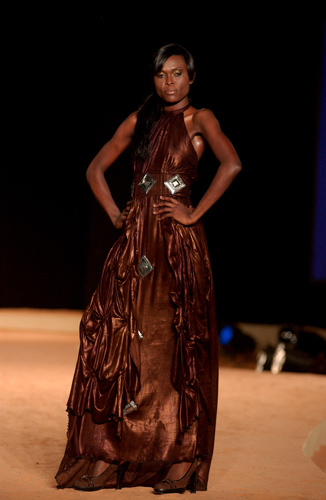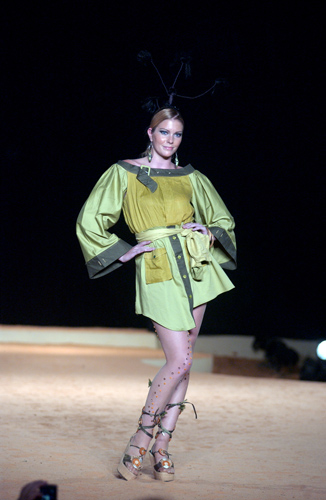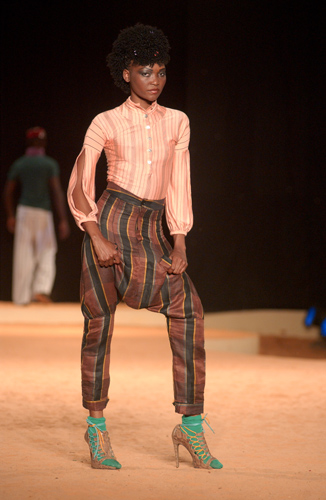Arguably, the most prominent element of FIMA’s aspirations to make a lasting impact on African economies and lives is its competition for young African designers, L’Afrique Est A La Mode (Africa Is In Style). Since the first competition in 2005, the event has been sponsored by Cultures France, an agency of France’s Ministry of Foreign Affairs. The contest is a featured event in the Festival’s schedule. In 2009, a large fashion show on the penultimate evening of the festivities was devoted to the ten finalists, each of whom presented ten ensembles. The work and the experiences of the finalists provide insights into the current state of fashion design in Africa. These young designers, like many in the generations that preceded them, manifest the same desire to combine local and global cultural influences. Their work also participates in global youth trends, embracing garments, accessories, and presentation styles that draw from stylish urban dress in many parts of the world.
A brief description of the competition’s parameters helps to elucidate the work of the finalists. Cultures France solicits dossiers through its networks in French cultural centers throughout Africa. The 2009 competition stipulated that entrants be between the ages of eighteen and thirty-five, and that they be independent designers whose work is marketed under their own name or brand. In addition, competitors must incorporate a development orientation into their work. They must have a project that aims to create sustainable development and employment in their home country, and they must be committed to producing and marketing their clothing designs in their home country. Thus, the contest reflects the mission of Cultures France and its Africa-focused program, Afrique en Créations, whose goals include the development of cultural sectors in Africa.
The ten finalists represented nine different countries, spanning the continent from Tunisia to South Africa, from Cameroon to Kenya. Some work in countries that have highly (or relatively) developed professional fashion industries, like Senegal and South Africa, where aspiring designers compete for access to systems for training, manufacture, and promotion of fashion. Others are from countries with limited fashion infrastructure, such as Namibia or Mozambique, where resources are limited but fewer designers seek to enter the market. Whatever their nations of origin, the young designers who were selected as finalists in the competition shared a common struggle to find clientele in markets that are dominated by Western brands, used clothing from Europe or the United States, and inexpensive Chinese imports. L’Afrique Est A La Mode offers one route to visibility for these designers, and for the winners it provides an opportunity for valuable training and connections, through an internship in a designer’s atelier, as well as a substantial cash prize.
The fashion show at which the young designers presented their collections was well attended and enthusiastically received. Packed rows audience members were seated on carpets, couches, pillows, stools, plastic chairs, and where chairs and carpets did not reach, directly on the sand. As each designer was announced and ten models strode down the runway, the crowd responded with applause, commentary, and occasional exclamations on the appearance of particularly dramatic ensembles. Following fashion show convention, each presentation concluded with the designer taking a turn on the runway, waving to the crowd while surrounded by models. The relief and excitement on the faces of the young designers, for whom the crowd of thousands was the largest audience they had ever encountered, was palpable. The diverse crowd, which ranged from dignitaries (on the upholstered couches) to local teenagers (on plastic chairs and hard sand), cheered the models and the designers on as if the runway might just as well have been a soccer field.
The clothing at the center of the event was as varied as the audience, ranging from T-shirts and sagging blue jeans to skintight body suits and formal gowns. Rather than discussing each of the finalists, I will use the work of the prize-winning designers as a means of elucidating the themes and approaches that broadly characterized the event. The first or Golden Thread prize, also called the Prix Ibrahim Loutou (named for the former Minister of Culture of Niger), was awarded to a South African designer. Thokozani Mbatha, who works under the brand name Black Pepper, won with a line of menswear; he was the only one of the ten finalists to present solely men’s clothing. The twenty-nine year old designer studied fashion at the Durban Institute of Technology, and he worked in the studio of Amanda Laird Cherry, one of South Africa’s leading designers. Mbatha described his sources of inspiration for the collection as a seemingly incongruous pairing: Nguni culture and Safari style. For him, the indigenous Nguni culture-his own heritage-and the colonial associations that are commonly attached to safari-style dress are not contradictory. He spoke of creating clothing for « a new, modern safari » that represents Africa as part of global trends. In Black Pepper’s design vocabulary, safari style evokes particular types of garments and animal prints rather making than a specific historical or cultural reference.
Mbatha’s accessories, rather than the garments themselves, created the association with Nguni culture. The ensembles were broadly urban and international in style, including shorts and T-shirts, satiny fabrics cut into chino-style trousers and collared shirts, and a jacket made of zebra-striped fabric. In a nod to the safari style, Mbatha presented a matched set of pants and short-sleeved shirt in the utilitarian style of the safari suit-epaulets on shoulders, flapped pockets on pants and shirt, and a thick leather belt around the waist. The soft drape and rich sheen of the fabric clearly distinguished the ensemble as from its sources of inspiration. The beads that adorned the models-necklaces, headbands, and belts-evoked Nguni cultures like the Zulu and Xhosa, who are famous for their elaborate beadwork. In a still more direct reference to this heritage, several models wore the large, disk-shaped earplugs (in the clip-on style). Earplugs, usually adorned with bold patterns in bright colors, are closely associated with Zulu identity. In a dramatic conclusion to the presentation, the final ensemble incorporated a leopard-print cape with a richly patterned magenta lining, worn with a fur headring and a beaded staff-clear references to Nguni dress. The garments themselves are contemporary, youthful, and stylish without signaling an association with any specific ethnic or regional identity.
The Silver Thread Prize was awarded to Salah Barka of Tunisia, a self-taught designer who worked as a model and a costume designer before turning his hand to fashion in 1998. His work is dramatic, incorporating unusual shapes, textures, and patterns. Barka cited Tunisian traditions as a source of inspiration for his work. Unlike Mbatha’s direct citations of Nguni dress practices, Barka incorporated approaches to garments-shapes and details-from Tunisian precedents. For instance, one style that appeared throughout his collection makes reference to a type of pants characteristic of historical men’s and women’s dress in Tunisia. The style resembles the pants associated with equestrianism in many parts of West Africa: ample fabric around the waist, with folds hanging between the legs from waist to knees. The Tunisian style pants are distinguished by tight-fitting calves; the transition from billowy waist to form-fitting legs creates a dramatic effect. Barka made reference to this form in a variety of men’s and women’s garments, using plaids, denim, and fabric with lurex sheen. He also incorporated hooded cloaks, broadly reminiscent of North African attire, and a red wool fez, a style worn throughout the region. These might be viewed as Tunisian- or North African-flavored garments, hinting at sources of inspiration without incorporating direct references.
The winner of the third or Copper Thread prize was Cameroonian designer Charlotte Mbatsogo, one of two finalists who had also presented at the previous L’Afrique Est A La Mode competition in 2007. Mbatsogo, who is twenty-five years old, trained at the Ecole Supérieure de Mode et de Design in Yaoundé. Her collection was inspired by nature and by environmental concerns. She made reference to recycling, one element of the global discourse on environmental sustainability, through the construction of garments out of pieces of other garments. A collar becomes a belt, a belt becomes a yoke, pockets appear as adornment around the bottoms of dresses, and buttons neatly emerge from buttonholes along apparently random edges and seams. Mbatsogo’s final ensemble was a dress with a gold lame halter-top and a full skirt made entirely of pieced together garment elements-pockets, sleeves, collars, belts, lapels. All of the disparate parts of the dresses were unified by color; Mbatsogo’s dominant color scheme, a range of greens and yellows, created a visual harmony among the parts and pieces. While these garments make reference to recycling, in fact they are not recycled. Each element was made expressly for the garment into which it is incorporated, transforming recycling into a stylistic rather than a literal practice.
The sole finalist from Niger, Hamidou Seydou Harira, received an honorable mention. Harira learned tailoring and design skills from the many members of her family who are engaged in clothing-related trades-her father is a tailor, her mother an embroiderer. Harira apprenticed with her brother, Ousmane Sambo Hamidou, who works under the name Sambo Style. He was himself a finalist in the 2005 edition of L’Afrique Est A La Mode, and he has become one of the city’s leading designers. In 2009, Harira took her turn on the FIMA runway, where she received a very enthusiastic reception from the hometown crowd. Their response likely reflected not only the twenty-four year old designer’s Nigerien identity, but also the distinctively local media and forms she incorporated into her collection.
Harira used shiny blue or brown cloth, made specifically for the Tuareg market, to create women’s formalwear. Though it is machine-made, the cloth resembles the fine, strip-woven cloth used to create Tuareg men’s turbans. This cloth is characteristically dyed with indigo, which is pounded into its surface to create a deep blue that glistens when it catches the light. Harira tailored and draped the cloth in layers, stretched it over hoops, and shaped it into halter-tops, skirts, and dresses. The garments were accessorized with engraved silver plaques and pendants in typical Tuareg style. Harira designed and commissioned these ornaments from jewelers at Niamey’s artisan market. The cloth and the silver pendants are dramatic forms and icons of Tuareg male identity, yet here they are transformed by a young Fulani woman into elegant women’s attire.
These designers, and the six other finalists as well, used a range of approaches to create collections that incorporated their own multilayered identities, steeped in local as well as global sources of influence. Thokozani Mbatha adapted forms directly from indigenous South African dress practices, using earplugs and beadwork to complement his menswear. Hamidou Seydou Harira used distinctively local cloth and ornaments, cut into garments that are international in style, while Salah Barka adapted a garment in Tunisian style to textiles that have no local associations. Finally, Charlotte Mbatsogo’s collection was inspired by an environmental theme, an issue that has local (as well as global) implications. The young designers’ competition echoes the themes and goals of the Festival International de la Mode Africaine, which is assertively Nigerien in its declarations of support for local economies, and simultaneously global in its aspirations.












